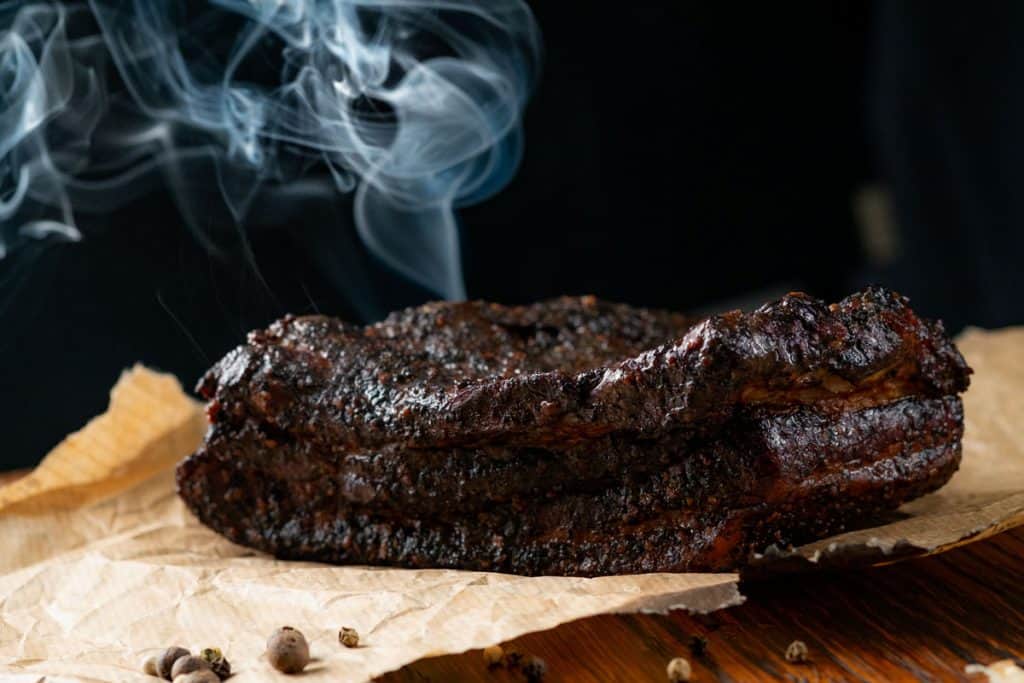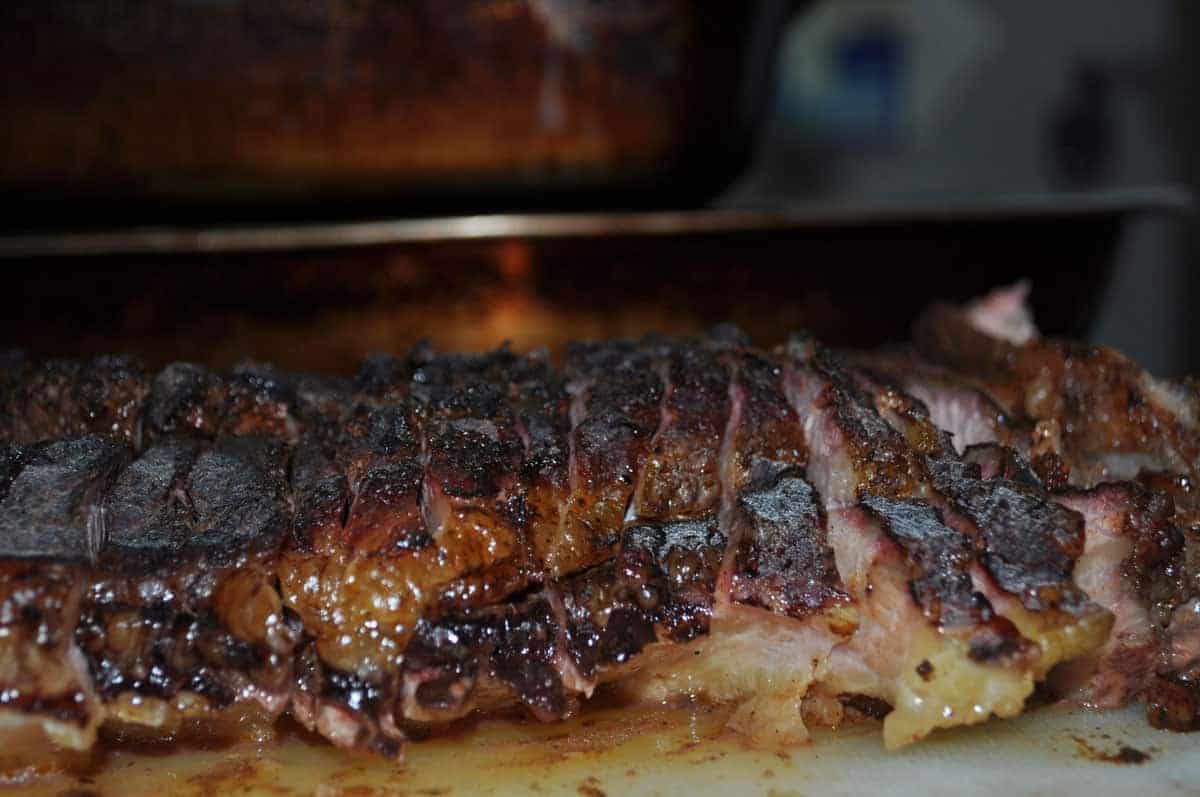Beef brisket might be a large cut of meat, but it will weigh much less when it comes out of the smoker than it did when you bought it. This comprehensive guide to brisket yield and serving sizes is designed to help you plan your next barbecue.
Brisket Yield
When it’s trimmed and cooked correctly, beef brisket has an average yield of 50 percent. While the point cut will cook down more than the flat end on account of the higher fat content, a 14-pound whole packer should turn out 7 to 8 pounds of edible meat.
Brisket 101
Beef brisket is a primal cut that’s taken from the lower chest region of the steer, right beneath the chuck. The chest muscles get a good workout supporting the overall weight of the animal. Since beef cattle typically weighs around 1200 pounds before butchering, this is a tall order.
All that movement results in a tough cut of meat that requires a long, slow cooking process in order to tenderize it. Brisket contains plenty of connective tissue, as well as the intramuscular fat that’s known in butcher’s circles as marbling. This gives the meat a robust beef flavor and helps keep it moist as it cooks.
Things to Consider

There are two main points you need to take into account as you estimate your brisket yield: the fat trimmings and the shrinkage factor.
Trimming the Fat
A whole packer brisket is labeled as such because it contains both of the subprimal cuts, which are known as the flat and the point. The flat is sometimes called the “first cut,” and it’s a lean piece of meat well-suited for slicing. The point, or the “deckle,” is fattier and often used to make ground beef.
When you buy a whole packer, you’re getting a brisket that still has all of the fat intact. The fat should be creamy white, with no discoloration or unsightly blemishes.
It can sometimes be hard to see the fat cap through the packaging, so you’ll have to use your judgment. That’s why it’s a good idea to find a local butcher you can trust, especially if you plan to smoke beef brisket and other large cuts on a regular basis.
Some pitmasters prefer to leave all the fat on a whole packer, claiming that it results in a more flavorful product. While it’s fine to leave the fat cap intact, we prefer to trim it to about 1/4 of an inch thick.
You might lose 1 to 2 pounds of weight during the trimming process, depending on the size of the brisket. Bear in mind, though, that you won’t be able to eat all that fat anyway. If it doesn’t render out as the meat cooks, you’ll just have to remove and discard it later, so you aren’t really losing anything if you trim it a bit.
About Shrinkage
According to the USDA, a whole beef brisket is roughly 70 percent water. Some of this moisture evaporates out as the meat cooks, which means the finished product will be much lighter than the raw brisket.
You can expect the brisket to shrink by about one-third by the time you take it out of the smoker. That means that if you’re starting with a 10-pound trimmed brisket, it should yield 6 to 7 pounds of cooked meat.
When it comes to shrinkage, we’ve found that it’s best to err on the side of caution, particularly when we’re serving a lot of people. Try to buy more than you think you’ll need. That way, you won’t have to worry if the brisket yield is a bit lower than you’d bargained for. You can always freeze the leftovers if you wind up with too much.
Putting it Together
So, after trimming the whole packer brisket and cooking it slowly at the correct temperature, how much meat can you expect to end up with? As a rule of thumb, you can expect the yield to be roughly 50 percent of the brisket’s starting weight.
When you trim a whole packer that weighs 14 pounds, you’ll probably lose about 1-1/2 to 2 pounds of fat. This will leave you with a 12-pound cut. During the smoke, it should shrink by another 30-35 percent, giving you a total yield of 7 to 8 pounds.
A Guide to Brisket Serving Sizes
How much meat you serve per person depends on a number of mitigating factors. The age of the guests, the time of the event, the number of side dishes you plan to serve—all of these can affect your estimate.
In the interest of keeping things simple, let’s start with a base amount of 1/2 pound of raw brisket per person. If you follow the logic of the brisket yield turning out to be 50 percent of the starting weight, that means you can expect a 14-pound whole packer to serve 28 people.
Bear in mind, however, that this number assumes a serving size of about 1/4 pound of cooked brisket per person. While this may be sufficient, it might not do the trick if all the guests are adults with hearty appetites. That’s another reason why we recommend making a more generous estimate at the outset.
Cooking the Point and Flat Separately
Since the brisket is composed of two different muscles, it’s possible to divide it in half and cook the point and flat separately. What does this mean for the overall meat yield?
Since the flat is usually slightly heavier than the point, you can expect the yield to be higher. Also, the meat contains less marbling, which means it won’t cook down as much as its fattier counterpart. If portion size is a concern, you’re better off smoking the flat over the point.
In our experience, the total yield for the flat will end up giving you the best value for each dollar spent. A 7-pound flat can yield as much as 4-1/2 pounds of edible brisket, which represents a significant upgrade from the 50 percent yield you might get from a whole packer.
That said, the meat from the point tends to be more flavorful, and all that rendered fat lends it a rich texture. Because the grain tends to run in more than one direction, it’s best to shred or chop the meat once it’s finished resting. You can also use the point to make burnt ends, which are crisp cubes of brisket tossed in barbecue sauce.
We like to estimate a yield of 40 percent when smoking the point alone. A 5-pound point cut could weigh as little as 2 pounds once it’s reached the sweet spot of 210 degrees Fahrenheit. As always, it’s better to have too much cooked brisket on your hands than to deal with hungry guests.
One more tip: If you want to stretch out the yield to serve more people, plan on serving the brisket in toasted rolls. You can get away with putting just 3 to 4 ounces of shredded beef in a sandwich, but sliced brisket calls for larger serving sizes.


Final Thoughts
Although it might be discouraging to think that your beautiful 14-pound brisket will cook down to half its original size, remember that meat shrinkage is inevitable. As long as you’ve done the job properly, you should end up with plenty of tantalizing beef.
Best of luck, and happy grilling!


Very helpful post thank you